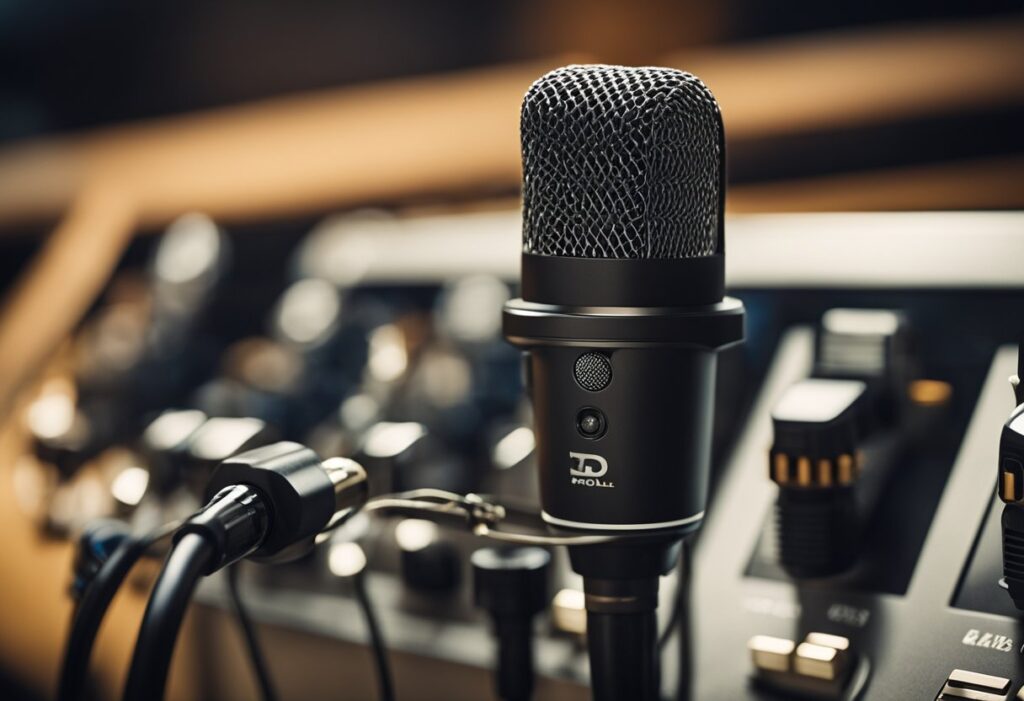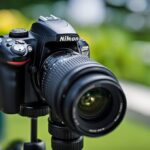Are you struggling to connect your XLR microphone to your amplifier? Choosing the right cable for the job can be confusing, especially if you’re new to audio equipment. In this article, we’ll guide you through the process of selecting the right cable to connect your XLR microphone to your amp, ensuring that you get the best possible sound quality.
Whether you’re a musician, podcaster, or public speaker, understanding how to connect your XLR microphone to your amplifier is an essential part of producing high-quality audio. In this article, we’ll cover everything you need to know about XLR microphones and the cables that connect them to amps. From understanding the different types of XLR cables to optimizing your audio performance, we’ve got you covered. So, let’s get started!
Table of Contents
ToggleUnderstanding XLR Microphones

XLR microphones are the industry standard for professional audio recording and live sound reinforcement. They are known for their balanced audio signal, which reduces noise and interference, resulting in a cleaner and clearer sound. In this section, you will learn about the different types of XLR microphones and the benefits of using them for audio.
Types of XLR Microphones
There are two main types of XLR microphones: dynamic and condenser. Dynamic microphones are rugged and durable, making them ideal for live performances and recording loud sounds such as drums and guitar amps.
On the other hand, condenser microphones are more sensitive and delicate, making them ideal for recording vocals, acoustic instruments, and other subtle sounds.
Benefits of Using XLR for Audio
XLR cables have three pins, which provide a balanced audio signal. This means that the audio signal is split into two phases, with one phase inverted, and then recombined at the other end. This process cancels out any noise or interference that may be picked up along the way, resulting in a cleaner and clearer sound.
Another benefit of using XLR for audio is that it provides phantom power. This is a DC voltage that is used to power condenser microphones. The power is sent through the XLR cable, eliminating the need for an external power source.
Related Posts:
What Cable to Connect XLR Microphone to Amp

When it comes to connecting an XLR microphone to an amplifier, there are a few different cable options available. In this section, we’ll explore the most common types of cables and what situations they are best suited for.
XLR to 1/4 Inch Cables
XLR to 1/4 inch cables are a popular choice for connecting microphones to amplifiers. These cables have an XLR connector on one end and a 1/4 inch connector on the other. They are commonly used in live sound applications and are ideal for connecting microphones to guitar amps or other musical instruments.
XLR to RCA Cables
XLR to RCA cables are another option for connecting microphones to amplifiers. These cables have an XLR connector on one end and an RCA connector on the other. They are commonly used in home audio setups and are ideal for connecting microphones to stereo systems or other audio equipment that uses RCA inputs.
Cable Length and Quality
When choosing a cable to connect your XLR microphone to an amplifier, it’s important to consider both the length and quality of the cable. Longer cables can result in signal loss and degradation, so it’s best to use the shortest cable possible while still allowing for adequate movement. Additionally, higher quality cables can help to minimize interference and improve overall sound quality.
Related Posts:
Connecting XLR Microphones to Amplifiers
If you are looking to connect an XLR microphone to an amplifier, you will need to follow a few basic steps. This guide will walk you through the process of connecting your XLR microphone to an amplifier, as well as troubleshooting common issues that may arise.
Step-by-Step Connection Guide
- First, ensure that your XLR microphone is properly powered. Some microphones require phantom power, which can be provided by your amplifier or an external power source.
- Locate the XLR input on your amplifier. This is usually labeled as “mic” or “microphone.”
- Connect your XLR microphone to your amplifier using an XLR cable. Insert one end of the XLR cable into the microphone and the other end into the XLR input on your amplifier.
- Turn on your amplifier and adjust the volume as needed.
- Test your microphone to ensure that it is working properly. Speak into the microphone and listen for sound coming from the amplifier.
Troubleshooting Common Issues
If you are experiencing issues with your XLR microphone connection, there are a few common issues that may be causing problems:
- Make sure that your XLR cable is properly connected to both the microphone and the amplifier. Loose connections can cause sound quality issues or no sound at all.
- Check to see if your microphone requires phantom power. If so, make sure that your amplifier is providing phantom power or that you are using an external power source.
- Adjust the volume on your amplifier to ensure that it is not too loud or too quiet. Overly loud sound can cause distortion, while overly quiet sound may not be audible.
By following these steps and troubleshooting common issues, you can connect your XLR microphone to an amplifier and achieve professional-quality audio.
Related Posts:
Optimizing Audio Performance
When it comes to connecting your XLR microphone to an amplifier, there are several factors that can impact the overall audio performance. In this section, we will explore some ways to optimize your setup and achieve the best possible sound quality.
Gain Staging
One important consideration when connecting your XLR microphone to an amp is gain staging. This refers to the process of setting the appropriate levels of gain at each stage of the signal chain, from the microphone to the amplifier. Proper gain staging can help prevent distortion and ensure a clear and balanced sound.
To optimize gain staging, start by setting the gain on your microphone to an appropriate level. Then, adjust the gain on your preamp or mixer to match the output level of the microphone. Finally, adjust the gain on your amplifier to achieve the desired volume level.
Use of DI Boxes
Another way to optimize your XLR microphone to amp connection is by using a DI (direct input) box. A DI box can help eliminate noise and interference caused by ground loops, as well as provide a balanced signal for longer cable runs.
When using a DI box, connect your XLR microphone to the input of the DI box, and then connect the output of the DI box to your amplifier. This can help improve the overall sound quality and reduce unwanted noise.
Cable Management
Finally, proper cable management is essential for optimizing audio performance. Use high-quality XLR cables that are shielded to prevent interference and noise. Keep your cables organized and avoid running them near power cables or other sources of interference.
By following these tips for gain staging, using DI boxes, and cable management, you can optimize your XLR microphone to amp connection and achieve the best possible audio performance.
Conclusion
When it comes to connecting an XLR microphone to an amp, it’s important to choose the right cable for the job. A balanced XLR cable is the best option as it will provide a clean signal and eliminate any unwanted noise or interference.
It’s also important to consider the length of the cable needed and the quality of the connectors. A high-quality cable with sturdy connectors will ensure a reliable connection and longevity.
Overall, taking the time to choose the right cable for your setup will ensure optimal performance and sound quality.
Frequently Asked Questions
Which type of cable is required to connect an XLR microphone to an audio amplifier?
To connect an XLR microphone to an audio amplifier, you will need an XLR cable. XLR cables are designed to transmit balanced audio signals, which is important for reducing noise and interference. These cables have three pins, with the first pin being ground, the second pin being the positive signal, and the third pin being the negative signal. The pins are arranged in a way that ensures that the positive and negative signals are transmitted equally, resulting in a clean and clear audio signal.
How do I properly connect an XLR microphone to a guitar amplifier?
Connecting an XLR microphone to a guitar amplifier is possible, but it requires some additional equipment. Most guitar amplifiers do not have XLR inputs, so you will need to use an XLR-to-1/4-inch adapter to connect the microphone to the amplifier. The adapter will plug into the XLR cable, and the other end of the adapter will plug into the 1/4-inch input on the amplifier.
Can I use a standard XLR cable to connect a microphone to an amplifier with RCA inputs?
It is possible to connect a microphone to an amplifier with RCA inputs using a standard XLR cable, but you will need an XLR-to-RCA adapter. The adapter will plug into the XLR cable, and the other end of the adapter will plug into the RCA input on the amplifier. It is important to note that using an XLR cable with an RCA input may result in a loss of audio quality, so it is recommended to use a cable that is specifically designed for RCA inputs.
What is the best way to integrate an XLR microphone into a karaoke mixer amplifier setup?
To integrate an XLR microphone into a karaoke mixer amplifier setup, you will need to connect the microphone to the mixer using an XLR cable. Once the microphone is connected to the mixer, you can adjust the levels and effects using the mixer’s controls. From there, you can connect the mixer to the amplifier using either XLR or RCA cables, depending on the inputs available on the amplifier.
Is it possible to connect a microphone directly to an amplifier without a mixer?
It is possible to connect a microphone directly to an amplifier without a mixer, but it is not recommended. Without a mixer, you will not be able to adjust the levels or add effects to the microphone’s signal, which can result in a poor quality audio signal. It is recommended to use a mixer to ensure that the microphone’s signal is properly adjusted and processed before being sent to the amplifier.
What are the necessary steps to connect a mixer to an amplifier using XLR cables?
To connect a mixer to an amplifier using XLR cables, you will need to connect the mixer’s output to the amplifier’s input using XLR cables. The mixer’s output will typically be labeled “Main Out” or “Master Out,” and the amplifier’s input will typically be labeled “Line In” or “Aux In.” Once the cables are connected, you can adjust the levels and effects using the mixer’s controls, and the audio signal will be sent to the amplifier for playback.








